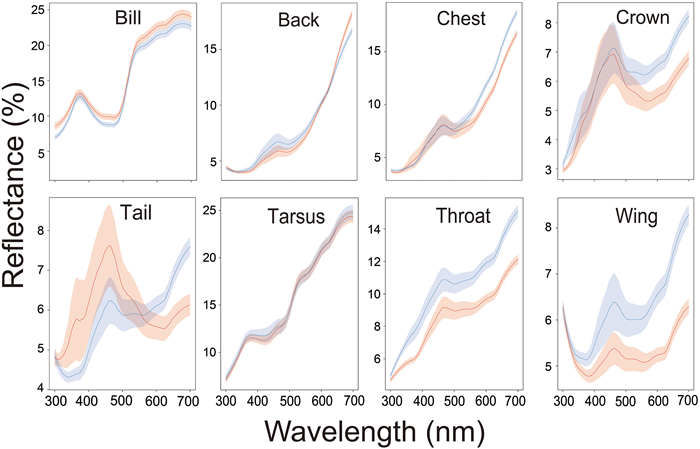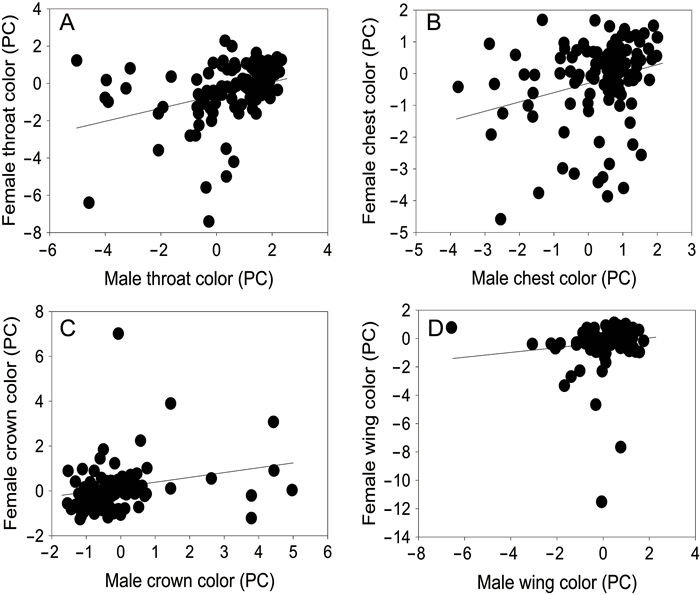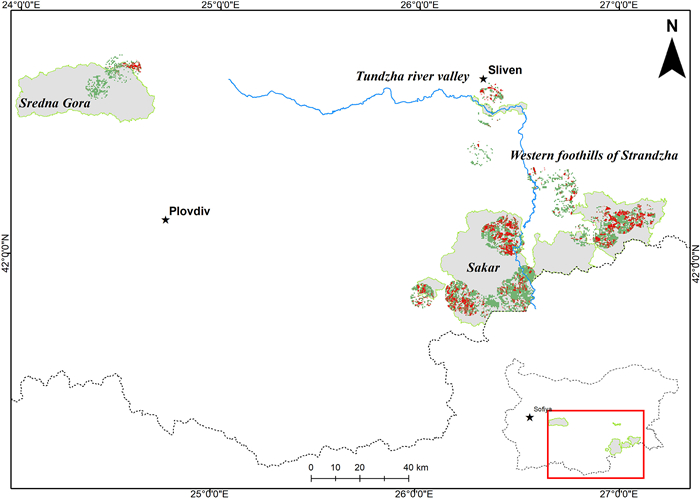|
Agrostatistics, 2011. BANAEC: final results on the occupancy and land use for the territory of Bulgaria in 2011. Bull. Minist. Agr. Food 182, 1-20. (in Bulgarian).
|
Arroyo, B., Garcia, J.T., Bretagnolle, V., 2002. Conservation of the Montagu's Harrier ( Circus pygargus) in agricultural areas. Anim. Conserv. 5, 283-290.
|
Balbontin, J., Penteriani, V., Ferrer, M., 2003. Variation in the age of mates as an early warning signal of changes in population trends? The case of Bonelli's Eagle in Andalusia. Biol. Conserv. 109, 417-423.
|
Battin, J., 2004. When good animals love bad habitats: ecological traps and the conservation of animal populations. Conserv. Biol. 18, 1482-1491.
|
Bender, D.J., Contreras, T.A., Fahrig, L., 1998. Habitat loss and population decline: a meta-analysis of the patch size effect. Ecology 79, 517-533.
|
BirdLife International, 2020. Species factsheet: Aquila heliaca. . (Accessed 12 May 2020).
|
|
Bondev, Z., 1991. Flora in Bulgaria. Publishing House "Kliment Ohridsky", Sofia. (in Bulgarian).
|
|
Bragin, E., 2000. On the demography of the Imperial Eagle Aquila heliaca in Kazakhstan. In: Chancellor, R.D., Meyburg, B. -U. (Eds. ), Raptors at Risk. WWGBP/Hancock House, pp. 409-413.
|
|
Burnham, K.P., Anderson, D.R., 2002. Model Selection and Multimodel Inference: A Practical Information-theoretic Approach. second ed. Springer, New York.
|
Cardador, L., Carrete, M., Manosa, S., 2011. Can intensive agricultural landscapes favour some raptor species? The Marsh Harrier in north-eastern Spain. Anim. Conserv. 14, 382-390.
|
Coates, P.S., Howe, K.B., Casazza, M.L., Delehanty, D.J., 2014. Landscape alterations influence differential habitat use of nesting buteos and ravens within sagebrush ecosystem: implications for transmission line development. Condor 116, 341-356.
|
|
del Hoyo, J., Elliott, A., Sargatal, J., 1994. Handbook of the Birds of the World. Vol. 2: New World Vultures to Guineafowl. Lynx Edicions, Barcelona.
|
Demerdzhiev, D., Boev, Z., Dobrev, D., Terziev, N., Nedyalkov, N., Stoychev, S., et al., 2022. Diet of Eastern Imperial Eagle ( Aquila heliaca) in Bulgaria: composition, distribution and variation. Biodivers. J. 10, e77746. .
|
|
Demerdzhiev, D.A., 2011. Eastern Imperial Eagle (Aquila heliaca heliaca Savigny, 1809) (ACCIPITRIDAE-AVES) in Bulgaria - distribution, biology, ecology, numbers, and conservation measures. Ph. D. thesis. BAS-NMNH, Sofia. (in Bulgarian with English summary).
|
|
Demerdzhiev, D.A., Dobrev, D.D., Stoychev, S.A., Levent, I.E., Petrov, Ts. H., Boev, Z.N., 2018. Long-term population survey of the Eastern Imperial Eagle in the Thracian Eco-region (Bulgaria and Turkey). Raptor. Conserv. Suppl. 1, 111-112.
|
|
Demerdzhiev, D.A., Popgeorgiev, G.S., Dobrev, D.D., Arkumarev, V.S., Terziev, N.G., 2019. Habitat requirements of the Lesser Spotted Eagle Clanga pomarina Brehm, 1831 (Aves: Accipitridae) at the southern periphery of the distribution range (southeast Bulgaria). Acta Zool. Bulg. Suppl. 14, 35-65.
|
|
Demerdzhiev, D.A., Horvath, M., Kovacs, A., Stoychev, S.A., Karyakin, I.V., 2011. Status and population trend of the Eastern Imperial Eagle (Aquila heliaca) in Europe in the period 2000-2010. Acta Zool. Bulg. Suppl. 3, 5-14.
|
Demerdzhiev, D.A., Stoychev, S.A., Dobrev, D.D., Spasov, S.D., Terziev, N.G., 2014b. Conservation measures undertaken to improve the population status of Eastern Imperial Eagle ( Aquila heliaca) in Bulgaria. Slovak Raptor J. 8, 27-39.
|
Demerdzhiev, D.A., Stoychev, S.S., Dobrev, D.D., Spasov S.D., Oppel, S., 2015. Studying the demographic drivers of an increasing Imperial Eagle population to inform conservation management. Biod. Conserv. 24: 627-639.
|
|
Demerdzhiev, D.A., Dobrev, V.D., Popgeorgiev, G.S., 2014a. Effects of habitat change on territory occupancy, breeding density and breeding success of Long-legged Buzzard (Buteo rufinus, Cretzschmar, 1927) in Besaparski Riodove Special Protection Area (Natura 2000), southern Bulgaria. Acta Zool. Bulg. Suppl. 5, 191-200.
|
|
Dobrev, V.D., Popgeorgiev, G.S., Plachiyski, D.G., 2014. Effects of the Common Agricultural Policy on the coverage of grassland habitats in Besaparski Ridove Special Protection Area (Natura 2000), southern Bulgaria. Acta Zool. Bulg. Suppl. 5, 147-155.
|
|
Donald, P.F., Collar, N.J., Marsden, S.J., Pain, D., 2013. Facing Extinction. The World's Rarest Birds and the Race to Save Them. Christopher Helm, London.
|
|
ESRI, 2016. ArcGIS Desktop: Release 10.4.1. Environmental Systems Research Institute, Redlands.
|
|
Ferguson-Lees, J., Christie, D.A., 2001. Raptors of the World. Christopher Helm, London.
|
Fernandez, M., Oria, J., Sanchez, R., Gonzalez, L.M., Margalida, T. 2009. Space use of adult Spanish Imperial Eagles Aquila adalberti. Acta Ornithol. 44, 17-26.
|
Ferrer, M., Donazar, J.A., 1996. Density-dependent fecundity by habitat heterogeneity in an increasing population of Spanish Imperial Eagles. Ecology 77, 69-74.
|
Ferrer, M., Morandini, V., 2017. Better nutritional condition changes the distribution of juvenile dispersal distances: an experiment with Spanish Imperial Eagles. J. Avian Biol. 48, 1342-1347.
|
Ferrer, M., Newton, I., Casado, E., 2006. How to test different density-dependent fecundity hypotheses in an increasing or stable population. J. Anim. Ecol. 75, 111-117.
|
Foley, J.A., DeFries, R., Asner, G.P., Barford, C., Bonan, G., Carpenter, S.R., et al., 2005. Global consequences of land use. Science 309, 570-574.
|
|
Galabov, Z., 1982. Physiographic regions. In: Galabov, Z. (Ed. ), Geography of Bulgaria, 3. Physiography. BAS, Sofia, pp. 315. (in Bulgarian).
|
Gill, F.B., Wolf, L.L., 1975. Economics of feeding territoriality in the Golden-winged Sunbird. Ecology 56, 333-345.
|
Gonzalez, L.M., Bustamante, J., Hiraldo, F., 1990. Factors influencing the present distribution of the Spanish Imperial Eagle ( Aquila adalberti). Biol. Conserv. 51, 311-319.
|
Gonzalez, L.M., Bustamante, J., Hiraldo, F., 1992. Nesting habitat selection by the Spanish Imperial Eagle Aquila adalberti. Biol. Conserv. 59, 45-50.
|
|
Green, R., 1979. Sampling Design and Statistical Methods for Environmental Biologists. John Wiley and Sons, New York.
|
|
Hammer, S., Harper, D.A.T., Ryan, P.D., 2001. PAST: paleontological statistics software package for education and data analysis. Palaeontol. Electron. 4, 9.
|
|
Horvath, M., Szitta, T., Firmanszky, G., Solti, B., Kovacs, A., Moskat, C., 2010. Spatial variation in prey composition and its possible effect on reproductive success in an expanding Eastern Imperial Eagle (Aquila heliaca) population. Acta Zool. Acad. Sci. H. 56, 187-200.
|
Horvath, M., Szitta, T., Bagyura, J., Fater, I., Firmanszky, G., Moskat, C., 2014. Simultaneous effect of habitat and age on reproductive success of Imperial Eagles ( Aquila heliaca) in Hungary. Ornis Hung. 22, 57-68.
|
Jaeger, J.A.G., Bertiller, R., Schwick, C., Muller, K., Steinmeier, C., Ewald, K.C., et al., 2008. Implementing landscape fragmentation as an indicator in the Swiss Monitoring System of Sustainable Development (Monet). J. Environ. Manage. 88, 737-751.
|
Jongman, R.H.G., 2002. Homogenisation and fragmentation of the European landscape: ecological consequences and solutions. Landscape Urban Plan. 58, 211-221.
|
|
Karyakin, I.V., 2018. Distribution, population number and status of the Eastern Imperial Eagle in Russia and Kazakhstan. Raptor. Conserv. Suppl. 1, 115-117.
|
Katzner, T., Bragin, E., Knick, S., Smith, A., 2005. Relationship between demographics and diet specificity of Imperial Eagles Aquila heliaca in Kazakhstan. Ibis 147, 576-586.
|
Krebs, J.R., 1971. Territory and breeding density in the Great Tit, Parus major L. Ecology 52, 2-22.
|
Liberatori, F., Penteriani, V., 2001. A long term analysis of the declining population of the Egyptian Vulture in the Italian peninsula: distribution, habitat preference, productivity and conservation implications. Biol. Conserv. 101, 381-389.
|
Margalida, A., Manosa, S., Gonzalez, L.M., Ortega, E., Sanchez, R., Oria, J., 2008. Breeding of non-adults and effect of age on productivity in the Spanish Imperial Eagle Aquila adalberti. Ardea 96, 173-180.
|
McClure, C.J.W., Westrip, J.R.S., Johnson, J.A., Schulwitz, S.E., Virani, M.Z., Davies, R., et al., 2018. State of the world's raptors: distributions, threats, and conservation recommendations. Biol. Conserv. 227, 390-402.
|
|
Meshinev, T., Apostolova, I., Georgiev, G., Dimitrov, V., Petrova, A., Veen, P., 2005. Grasslands of Bulgaria. Final report on the National Grasslands Inventory Project, Bulgaria, 2001-2004. (PINMATRA/2001/020). Dragon 2003 Publishers, Sofia.
|
Murgatroyd, M., Underhill, G.L., Rodrigues, L., Amar, A., 2016. The influence of agricultural transformation on the breeding performance of a top predator: Verreaux's Eagles in contrasting land use areas. Condor 118, 238-252.
|
Newbold, T., Hudson, L.N., Hill, S.L.L., Contu, S., Lysenko I., Senior, R.A., et al., 2015. Global effects of land use on local terrestrial biodiversity. Nature 520, 45-50.
|
|
Newton, I., 1979. Population Ecology of Raptors. T. and A.D. Poyser, Berkhamsted.
|
|
Newton, I., 1991. Habitat variation and population regulation in sparrowhawks. Ibis 133, 76-88.
|
|
Patterson, I.J., 1980. Territorial behaviour and the limitation of population density. Ardea 68, 53-62.
|
|
Pedrini, P., Sergio, F., 2001. Density, productivity, diet and human persecution of Golden Eagles (Aquila chrysaetos) in the central-eastern Italian Alps. J. Raptor Res. 35, 40-48.
|
Penteriani, V., Balbontin, J., Ferrer, M., 2003. Simultaneous effects of age and territory quality on fecundity in Bonelli's Eagle ( Hieraaetus fasciatus). Ibis 145, 77-82.
|
|
Penteriani, V., Gallardo, M., Roche, P., Cazassus, H., 2001. Effects of landscape spatial structure and composition on the settlement of the Eagle Owl Bubo bubo in a Mediterranean habitat. Ardea 89, 331-340.
|
Pongracz, A., Szitta, T., 2015. Current situation and population trend of the lesser spotted eagle ( Aquila pomarina) in Hungary. Raptor J. 9, 65-69.
|
Pulliam, H.R., 1988. Sources, sinks, and population regulation. Am. Nat. 132, 652-661.
|
|
R Core Team, 2012. R: a language and environment for statistical computing. R Foundation for Statistical Computing, Vienna.
|
Real, J., Manosa, S., 1997. Demography and conservation of western European Bonelli's eagle Hieraaetus fasciatus populations. Biol. Conserv. 79, 59-66.
|
Reynolds, R.T., Lambert, J. S, Kay, S.L., Sanderlin, J.S., Bird, B.J., 2019. Factors affecting lifetime reproduction, long-term territory-specific reproduction, and estimation of habitat quality in northern goshawks. PLoS ONE 14, e0215841.
|
Rudnick, J.A., Katzner, T.E., Bragin, E.A., Rhodes, O.E., Dewoody, J.A., 2005. Using naturally shed feathers for individual identification, genetic parentage analyses, and population monitoring in an endangered Eastern Imperial Eagle Aquila heliaca population from Kazakhstan. Mol. Ecol. 14, 2959-2967.
|
Sara, M., Di Vittorio, M., 2003. Factors influencing the distribution, abundance and nest-site selection of an endangered Egyptian vulture ( Neophron percnopterus) population in Sicily. Anim. Conserv. 6, 317-328.
|
Schlaepfer, M.A., Runge, M.C., Sherman, P.W., 2002. Ecological and evolutionary traps. Trend. Ecol. Evol. 17, 474-480.
|
Sergio, F., Newton, I., 2003. Occupancy as a measure of territory quality. J. Anim. Ecol. 72, 857-865.
|
Sergio, F., Blas, J., Baos, R., Forero, M.G., Donazar, J.A., Hiraldo, F., 2009. Short- and long-term consequences of individual and territory quality in a long-lived bird. Oecologia 160, 507-514.
|
|
Shannon, C.E., Weaver, W., 1949. The mathematical theory of communication. University of Illinois Press, Urbana.
|
StatSoft Inc., 2011. STATISTICA (data analysis software system), version 10. .
|
Steenhof, K., Kochert, M.N., Doremus, J.H., 1983. Nesting of subadult golden eagles in Southwestern Idaho. Auk 100, 743-747.
|
Sternalski, A., Mougeot, F., Bretagnolle, V., 2012a. Carotenoid limitation and allocation priorities in asynchronous raptor nestlings. Biol. J. Linn. Soc. 105, 13-24.
|
Sternalski, A., Mougeot, F., Eraud, C., Gangloff, B., Villers, A., Bretagnolle, V., 2010. Carotenoids in nestling Montagu's Harriers: variations according to age, sex, body condition and evidence for diet-related limitations. J. Comp. Physiol. 180, 33-43.
|
Sternalski, A., Mougeot, F., Perez-Rodriguez, L., Bretagnolle, V., 2012b. Carotenoid-based coloration, condition, and immune responsiveness in the nestlings of a sexually dimorphic bird of prey. Physiol. Biochem. Zool. 85, 364-375.
|
Sternalski, A., Blanc, J.F., Augiron, S., Rocheteau, V., Bretagnolle, V., 2013. Comparative breeding performance of Marsh Harriers Circus aeruginosus along a gradient of land use intensification and implications for population management. Ibis 155, 55-67.
|
Tittler, R., Fahrig, L., Villard, M.A., 2006. Evidence of large-scale source-sink dynamics and long-distance dispersal among wood thrush populations. Ecology 87, 3029-3036.
|
Vali, U., Tuvi, J., Sein, G., 2017. Agricultural land use shapes habitat selection, foraging and reproductive success of the Lesser Spotted Eagle Clanga pomarina. J. Ornithol. 158, 841-850.
|
|
Vili, N., Szabo, K., Kovacs, S., Kabai, P., Kalmar, L., Horvath, M., 2013. High turnover rate revealed by noninvasive genetic analyses in an expanding Eastern Imperial Eagle population. Acta Zool. Acad. Sci. H. 59, 279-295.
|
|
Whitfield, D.P., Fielding, A.H., Gregory, M.J.P., Gordon, A.G., McLeod, D.R.A., Haworth, P.F., 2007. Complex effects of habitat loss on Golden Eagles Aquila chrysaetos. Ibis 149, 26-3.
|



 DownLoad:
DownLoad:








 Email Alerts
Email Alerts RSS Feeds
RSS Feeds